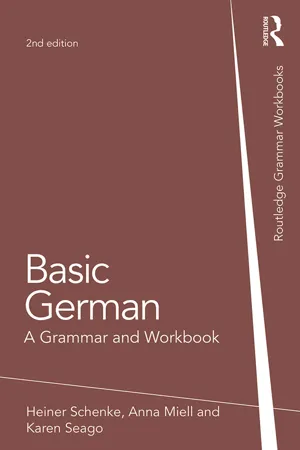
- 214 pages
- English
- ePUB (mobile friendly)
- Available on iOS & Android
About this book
Basic German: A Grammar and Workbook comprises an accessible reference grammar and related exercises in a single volume.
The book introduces German people and culture through the medium of the language used today, covering the core material which students would expect to encounter in their first years of learning German.
Each of the 29 units presents one or more related grammar topics, illustrated by examples which serve as models for the exercises that follow. These wide-ranging and varied exercises enable the student to master each grammar point thoroughly.
Features include:
• Clear grammatical explanations with examples in both English and German
• Authentic language samples from a range of media
• Checklists at the end of each unit to reinforce key points
• Cross-referencing to other grammar chapters
• Full exercise answer key
• 'Did you know?' sections with extra learning tips on specific grammar points and insights into current usage of German
• Glossary of grammatical terms
The new edition has been thoroughly revised, including more varied exercises for practice, and grammar points have been reformulated to use a more learner-centred approach.
Suitable for independent study and for class use, Basic German: A Grammar and Workbook is the ideal reference and practice book for beginners, as well as for students with some knowledge of the language.
Frequently asked questions
- Essential is ideal for learners and professionals who enjoy exploring a wide range of subjects. Access the Essential Library with 800,000+ trusted titles and best-sellers across business, personal growth, and the humanities. Includes unlimited reading time and Standard Read Aloud voice.
- Complete: Perfect for advanced learners and researchers needing full, unrestricted access. Unlock 1.4M+ books across hundreds of subjects, including academic and specialized titles. The Complete Plan also includes advanced features like Premium Read Aloud and Research Assistant.
Please note we cannot support devices running on iOS 13 and Android 7 or earlier. Learn more about using the app.
Information
Unit 1
What’s different in German?
Basic tips and patterns
Spelling – capital letters and different characters
Capital letters for nouns
- Am Wochenende gehen der Mann und die Frau zu einem Yogakurs.
- At the weekend the man and the woman go to a yoga course.
Different characters
ß – the sharp ‘s’
| heißen | to be called |
| Straße | street |
| groß | big |
The umlauts – ä, ö, ü
- Mutter means ‘mother’, but Mütter is the plural form and means ‘mothers’.
- Musste means ‘had to’, but müsste means ‘should’ or ‘ought to’.
Three genders
| der Tisch | the table (masculine) |
| die Tür | the door (feminine) |
| das Fenster | the window (neuter) |
Endings
Verbs
| Ich gehe. | I go. |
| Er geht. | He goes. |
| Sie gehen. | They go. |
Articles and possessive adjectives
| Ist das ein Mann? | Is that a man? |
| Da drüben sehe ich ein en Mann. | I can see a man over there. |
Adjectives
Cases
| Der Hund beißt den Mann. | The dog bites the man. |
| Der Hund beißt den Mann. | The dog bites the man. |
Word order
| Er hat zwei Brüder. | He has two brothers. |
| Morgen fahre ich nach Paris. | Tomorrow I’m going to Paris. |
| Öffnen Sie das Fenster! | Open the window, please. |
| Hast du ein Tablet? | Do you have a tablet? |
| Ich kann morgen nicht kommen, weil ich nach Paris fahre. |
| I can’t come tomorrow because I’m going to Paris. |
Tenses
Table of contents
- Cover
- Title
- Copyright
- Contents
- Preface
- 1 What’s different in German? Basic tips and patterns
- 2 Verbs in the present tense
- 3 Verb variations and irregular verbs
- 4 Irregular verbs: haben and sein
- 5 Separable verbs in the present tense
- 6 Imperatives
- 7 Questions
- 8 Articles
- 9 Nouns and gender
- 10 Plural of nouns
- 11 The four cases
- 12 The nominative case
- 13 The accusative case
- 14 The dative case
- 15 The genitive case
- 16 Personal pronouns
- 17 Possessive adjectives
- 18 Reflexive verbs
- 19 Negatives
- 20 Comparison of adjectives and adverbs
- 21 Modal verbs
- 22 The present perfect tense
- 23 The simple past tense
- 24 The future tense
- 25 Prepositions
- 26 Adjective endings
- 27 Numbers and dates
- 28 Conjunctions and clauses
- 29 Word order
- Key to exercises and checklists
- Glossary of grammatical terms
- Common irregular verbs
- Index